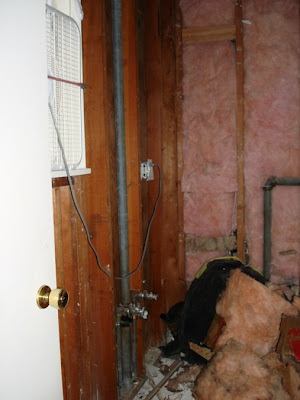There hasn't been time or energy to do much work on the master bathroom rehab. I did pull down some insulation and the small amount of remaining drywall today. This is also a form of meditation, even if it seems like work to others.
What is done so far:
1. Removal of sink, counter, and toilet.
2. Removal of shower.
3. Removal of wall dividing bathroom from empty space on northwest corner, to enlarge bathroom.
4. Removal of closet wall on east side, also to enlarge bathroom.
5. Seal closet doors to reduce dust mess in house.
6. Removal of ceiling drywall.
7. Removal of remaining walls' drywall.
8. Punch holes through wall into hallway. OK, that was a mistake.
9. Repair holes noted in #7.
10. Tear down crappy, inadequate insulation from ceiling and outside wall.
11. Dispose of all of that demolition trash (2 trips to dump, one to go).
What remains of deconstruction:
12. Construct temporary wall in bedroom so that I can tear out the closet doors and re-frame for pocket door.
13. Remove solid oak flooring from former closet to save for bedroom floor patch.
14. Seal off shower pipe and sink pipe.
15. Remove remaining flooring.
Then it's just a big box, deconstruction is done, and construction can begin.

Northwest corner. You can see the nice mold-proof paperless drywall that I used for the adjoining guest bath.

Southwest corner. The insulation is for the tub surround of the adjoining guest bath.

The floor. Actually demolition trash, none of which is reusable. Unlike all of the framing that was removed - it is almost all reusable, and is better than the new stuff. The 2X4s are all stored in the basement, waiting for their new role.

Ceiling. You might say, why tear out all of the fiberglass insulation. Answer: It's inadequate, only being 3 inches thick. It's filled with dust and dirt, reducing the R value even more. The paper backing is brittle and probably can't be reinstalled even if I want to. There is no vapor barrier. All in all, it's better to remove it all and start over with the right stuff, installed correctly and to code.